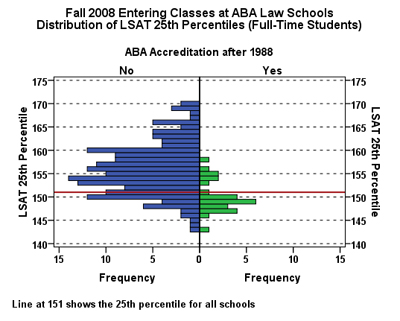In my recent comments to the ABA Standards Review Committee on the proposed changes to Interpretation 301-6, Endangered: Historically Black Law Schools?, I identified Atlanta’s John Marshall Law School as “arguably” one of the Historically Black Law Schools. This was based in part on the high percentage of its entering students that are Blacks/African Americans. It also was based on a what I now know to be a mis-identification of Atlanta’s John Marshall as the “School X” discussed by Prof. John Nussbaumer (Cooley) in his article, Misuse of the Law School Admission Test, Racial Discrimination and the De Facto Quota System for Restricting African-American Access to the Legal Profession, 80 ST. JOHN’S L. REV. 167, 177 (2006).
In “Case Study One–Initial Accreditation,” School X was seeking full ABA approval. During School X’s transition from provisional to full ABA approval, the share of its student body that were Black/African American fell from 62% to 32% over just five years (1999 to 2004). School X was located in “a major metropolitan area with a large minority and African-American population” and had recently obtained full ABA approval. In trying to identify School X, I noted that Atlanta’s John Marshall, located in Atlanta, was ABA-accredited in 2004.
Imagine my surprise when I got the The Gateway to the Profession, the Consultant on Legal Education’s 2009-2010 Annual Report on the activities of the ABA Section of Legal Education during that academic year. Under the “approvals and Acquiescences Granted in 2009-2010”, there was a photo captioned “Atlanta’s John Marshall Law School.” The first paragraph of that portion of the report said that Atlanta’s John Marshall was granted full approval on December 5, 2009.
The entries for LSAT 25th percentile, total enrollment, minority enrollment, and African-American enrollment shown in Table 9 of Nussbaumer’s article, id. at 181-F, match the entries for the David A. Clarke School of Law of the University of the District of Columbia in the 2001 through 2006 Official Guides. According to Ingredients to Higher Education, the 2004/2005 Annual Report by the ABA Consultant on Legal Education, UDC was granted provisional ABA accreditation in 1998, and full ABA accreditation on August 4, 2005.
My mistake does not diminish the importance of Atlanta’s John Marshall. Not only was that law school one of the first Southern law schools to integrate, it has the highest Black/African-American enrollment of any law school that is not an Historically Black Law School.
posted by Gary Rosin
